Accessing the Light Source Parameters
You can access the light source parameters.
Right-click the light in the specification tree.
Select
Light object > Definition to open the Properties dialog
box:
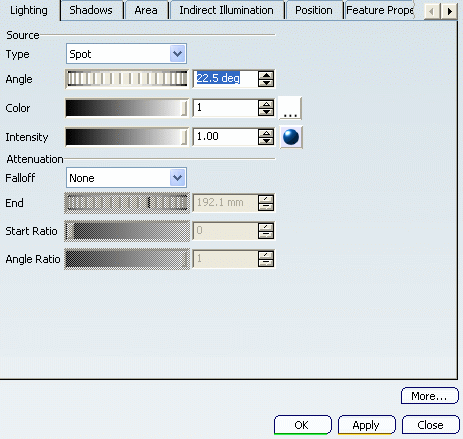

Modifying the Lighting Parameters
You can modify the lighting parameters.
Select the Lighting tab. If you want to modify the source type, in the Type
list select Spot, Point or Directional.
Use the Color slider to
modify the color intensity, then click
 if you want to choose another color (the default color is white).
if you want to choose another color (the default color is white). For more detailed information, refer to
Applying a Color Using the Color Chooser. Use the Intensity slider to define the light
intensity or enter a value directly in the box. Click
 to define the intensity more precisely.
to define the intensity more precisely. For more detailed information refer to
More about Adjusting Light Source Parameters. The Falloff box lets you define the
More about Adjusting Light Source Parameters (which is set to None by default). Use the Angle slider to modify the source
angle.
The
source angle defines the half-angle of the cone, that is the angle between
the axis of revolution and the cone edge (for spot light sources only).
The angle is a value between 0 deg and 90 deg. This means that a value
of 90 deg would generate a light source equivalent to a punctual light
source.


Use the sliders in the Attenuation area to
modify the lighting attenuation parameters.
For more detailed information on the attenuation parameters, refer to
More about Adjusting Light Source Parameters.

Accessing the Physical Light Parameter
You can access the physical light parameter.
Right-click the light in the specification tree.
Select
Light object > Definition to open the Properties dialog
box:
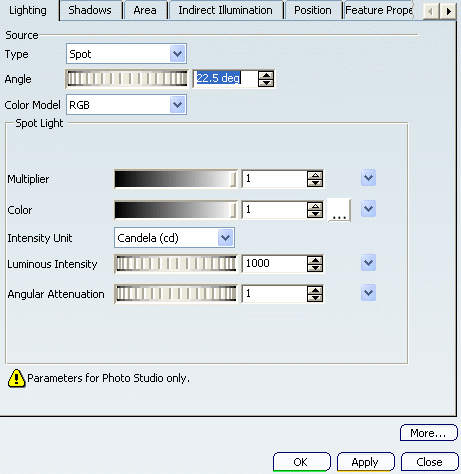

Modifying the Lighting Parameters
You can modify the lighting parameters.
Select the Lighting tab. If you want to modify the source type, in the Type
list select Spot, Point, Sun or Photometric.
Use the Angle slider to modify the source
angle.
The
source angle defines the half-angle of the cone, that is the angle between
the axis of revolution and the cone edge (for spot light sources only).
The angle is a value between 0 deg and 90 deg. This means that a value
of 90 deg would generate a light source equivalent to a punctual light
source.


Choose the color model between RGB and Temperature. If you choose RGB, use the Color slider to
modify the color intensity, then click
 if you want to choose another color (the default color is white).
if you want to choose another color (the default color is white). For more detailed information, refer to
Applying a Color Using the Color Chooser. If you choose the Temperature option, use the Temperature slider to modify the temperature. Use the Luminous intensity slider to define light intensity or enter a value directly in the box. Use the Angular attenuation to modify angle attenuation or enter a value directly in the box.

Modifying the Light Source Position
You can modify the light source position.
Select the Position tab
to define the light source anchoring point and the point to which the
source is directed, respectively in the Origin and Target
areas.
You can define this position in millimeters along the
X, Y and Z axes.
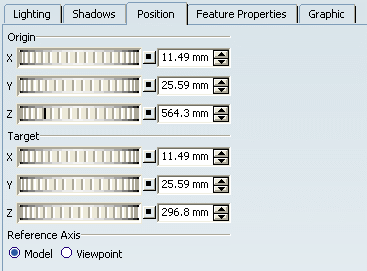
The Reference Axis
area lets you define the light source position relative to the
Model axis or to the Viewpoint according to the option
you select:
- Model
By default, any light source you create is positioned relative
to the model and thus, moving the viewpoint moves the light
source along the model.
- Viewpoint
Attaching a light source to the viewpoint means that moving
the viewpoint only moves the model; the light source keeps
the same position in the window. When a light source is
attached to the viewpoint, it is identified by an anchor
symbol in the specification tree as shown below for Light.1:
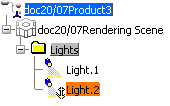
Click OK to validate the new parameters.

Modifying the Area Diffusion
You can modify the area diffusion.
Double-click a light from the specification tree or
directly in the representation.
The Properties dialog box opens. Select the Area tab to delimit the diffusion
area.
 Modify the parameters you can find in the Geometry frame. The options presented help you to define the surface of the light diffusion. Click OK to validate the new parameters.

Modifying the Indirect Illumination
You can modify the indirect illumination.
Double-click a light from the specification tree or
directly in the representation.
The Properties dialog box opens. Select the Indirect Illumination tab to define
the indirect illumination you need.
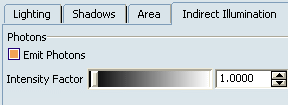
Activate the Emit Photons option. The Intensity Factor parameter is now available.
Move the bar or use the Up and Down arrows to choose
the value you want for the Intensity factor. Click OK to validate the new parameters.
|